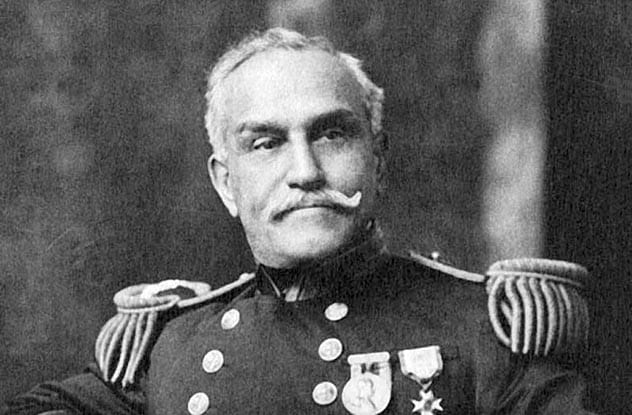 Mysteries
Mysteries  Mysteries
Mysteries  History
History 10 Surprising Stories About the Texas Rangers
 Humans
Humans 10 Philosophers Who Were Driven Mad by Their Own Theories
 Miscellaneous
Miscellaneous 10 Video-Game-Worthy Weapons and Armors from History
 Weird Stuff
Weird Stuff 10 Psychics Who Accurately Predicted Wartime Events
 The Arts
The Arts 10 Pieces of Art Inspired by a Broken Heart
 Health
Health 10 Science Fiction-Sounding New Medical Treatments
 History
History 10 Surprising Facts About the Father of Submarine Warfare
 Space
Space Ten Astonishing New Insights into Alien Worlds
 Weird Stuff
Weird Stuff 10 Bizarre Summer Solstice Rituals Still Practiced Today
 Mysteries
Mysteries Top 10 Haunting Facts About the Ghost Ship MV Alta
 History
History 10 Surprising Stories About the Texas Rangers
 Humans
Humans 10 Philosophers Who Were Driven Mad by Their Own Theories
Who's Behind Listverse?

Jamie Frater
Head Editor
Jamie founded Listverse due to an insatiable desire to share fascinating, obscure, and bizarre facts. He has been a guest speaker on numerous national radio and television stations and is a five time published author.
More About Us Miscellaneous
Miscellaneous 10 Video-Game-Worthy Weapons and Armors from History
 Weird Stuff
Weird Stuff 10 Psychics Who Accurately Predicted Wartime Events
 The Arts
The Arts 10 Pieces of Art Inspired by a Broken Heart
 Health
Health 10 Science Fiction-Sounding New Medical Treatments
 History
History 10 Surprising Facts About the Father of Submarine Warfare
 Space
Space Ten Astonishing New Insights into Alien Worlds
 Weird Stuff
Weird Stuff 10 Bizarre Summer Solstice Rituals Still Practiced Today
10 Paranormal Mysteries That Are Not Paranormal Mysteries
Right from the start, tales of things that are just so weird they can only be described as ‘Paranormal’ — “beyond normal” — have been popular. They give a ‘what if’ back to a world that so often claims to be perfectly explainable. These encounters can be spooky, thrilling, and fun, which should be a warning, because often real life isn’t any of those things. Yes, there are paranormal mysteries that might actually lead to new discoveries about science, the world, and ourselves, but many really are just entertainment, created by people who are were interested in attention and money than actual paranormal stuff.
See Also: 10 Paranormal Events Linked To Mass Tragedies
10. Magic Bullets

Charles Fort is famous for four books he wrote in the early 1900s that collected what he called “damned data”… stuff that is now usually labeled as ‘paranormal.’ Fort’s books were instrumental in creating continuing interest in such matters, but, of course, that doesn’t necessarily mean everything he printed was truthful. In Fort’s 1932 book Wild Talents, he presents examples of people being found shot to death with no bullet holes in their clothing, a somewhat perplexing problem. Fort’s primary example of such a situation is the 1872 death of Captain Colvocoresses in Bridgeport, Connecticut, USA, which Fort covers very simply, “shot through the heart — clothes not perforated.”
In reality, most of Colvocoresses’ clothes were very much perforated, but one newspaper article — the one that Fort gives as his source for the story — mentioned that the front of Colvocoresses’ jacket was not penetrated by the bullet, as if the gun was inside the jacket when fired. While Fort used this detail to claim that none of the clothing was perforated, the insurance companies involved at the time took it to mean Colvocoresses had shot himself, holding his jacket open. It seems that Colvocoresses — who had a large family and no job prospects — had only recently taken out some ridiculously large insurance policies on his own life, and may have arranged for a suicide to look like a murder![1]
9. One for the Explorer’s Club

In the 1950s and 1960s, Ivan T. Sanderson was THE expert on the so-called “Abominable Snowman” or “Yeti,” the hairy wild man of the Himalayas, a subject that had become extremely popular in magazines and newspapers at the time. So when Sanderson reported that, in 1902, a group of soldiers investigating the disappearance of workmen stringing a telegraph line instead discovered and shot a Yeti in the Jelep-La pass on the border of Tibet and India, people were astounded. The beast had been 10 feet tall, covered with hair everywhere but on its face, and had “long yellow fangs,” and sadly, appears to have been lost when it was shipped to England.
Unfortunately for Yeti fans, in this case official accounts of the stringing of the telegraph line, written independently by men who were there, make no mention at all of these events occurring. The story appears to have been invented in 1957 and Sanderson picked it up and added claims of having seen “government reports” to make the tale sound more authentic.[2]
8. A Real Scorcher

According to many paranormal researchers, April 7, 1938 was a particularly strange day. In Upton-by-Chester, England, George Turner was driving along a quiet road. Out at sea, helmsman John Greeley piloted the SS Ulrich. In Denmark, 18-year-old Willem Ten Bruik was driving through the countryside. And then all of three of them burst into flames for no apparent reason. Turner’s car was discovered overturned in a ditch; seamen rushed to the pilot house when the SS Ulrich began to lurch, only to find Greeley aflame and Ten Bruik was discovered in his car burned beyond recognition. Strangely in all cases, the damage from the flames was limited to just the human victims, leaving the vehicles unburned. Experts all agreed: each was an example of Spontaneous Human Combustion, but no one could guess why all three died the same day, and apparently at the same time!
Luckily for those of you worried about Spontaneous Human Combustion, there never was a George Turner, Willem Ten Bruik, nor John Greeley; and a ship by the name of ‘SS Ulrich’ never existed. The whole story seems to have been cobbled together from various mis-reported details and then presented as a truly mystifying example of supernatural spontaneous combustion deaths, but each story has fallen apart when investigated.[3]
7. Deja Vu… in Green

In 1965, author John Macklin reported a truly weird event; one for which, he assured readers, he had seen documents, reports, and witness testimony that proved the event occurred. In August, 1887, Macklin stated, two children — a boy and a girl — were discovered in a shallow cave near the village of Banjos in Spain. The children didn’t speak Spanish, wore clothes that appeared to be made from a metallic cloth, and had green skin.
Though the locals tried to care for the children, the boy sickened and died soon after the discovery. The girl lived five years past her discovery, and her skin gradually became a normal tone. After she learned enough Spanish, she said she and her brother had come from a land with no sun; that everyone there had green skin; and they lived in perpetual twilight. She never was able to explain how she and her brother had somehow traveled to where they had been discovered from their own land.
But Macklin’s tale was just a re-telling of a truly mysterious event that occurred in Woolpit, England, in the 13th Century. All Macklin did was change the time and place of the events to create a “new” paranormal account. Ironically, some later ‘researchers’ claimed that Macklin’s story proved the Woolpit story must have happened, since there were so many similarities! The Woolpit event, however, was one of a kind; and it remains a mystery to this day.[4]
6. The Final Getaway

In November, 1856, John Wilhelm Gebhard was hanged for a murder he insisted he had not committed. Gebhard claimed innocence to the end, finally declaring that though he would die, no grave should ever hold his body. He was buried near the prison in an eight-foot-deep grave, and a cairn of rocks was built up over the spot. In addition, the governor was worried about attempts being made to exhume Gebhard’s body to re-bury it in consecrated grounds, so he placed his official seal on the coffin and ordered armed guards to watch the grave day and night for three months after the execution.
But only six weeks later, the real murderer was discovered; and this person had also been the chief witness against Gebhard in the trial. Clearly, a grave miscarriage of justice had occurred, and the governor and the prison were quick to try and make amends. Gebhard’s name was cleared and his mother was given a lifelong pension, and Gebhard’s corpse was ordered to be exhumed and given a proper burial in a graveyard. The grave was opened, and the seals checked and confirmed to be intact, but the coffin was empty. The body of John Gebhard was never found.
The story of John Gebhard’s paranormal escape from the grave is actually based in fact; there really was a man named John Wilhelm Louis Gebhard who was hanged for a murder he didn’t commit, but this Gebhard died in 1822, and his body most definitely didn’t vanish. The story of his death, however, served as the starting point for the inventive — and false — legend of the vanishing corpse.[5]
See Also: Top 10 Creepiest Episodes Of Paranormal Television
5. Dufferin’s Warning

A story is often told about Lord Dufferin [1826-1902], a very successful English diplomat, who was publicly well-known and liked. On holiday, Dufferin and his wife stayed at a friend’s home in Ireland. One night while there, Dufferin saw a strange man carrying a coffin across the garden of the house. The man lifted his head and looked directly at Dufferin, in his upper story window and the man’s face was so indescribably ugly that Dufferin was struck incapable of looking away or reacting. The strange man soon disappeared into the depths of the night, but Dufferin was left with a horrifying memory of the man’s visage.
Years later Lord Dufferin, now England’s ambassador to France, was at the Grand Hotel in Paris for a diplomatic reception, waiting for the elevator. When the elevator opened, however, he immediately stepped back as the elevator operator was unmistakably the same man who had terrified him so long before. Dufferin, instead of entering the elevator, headed for the front desk to ask what they knew of the strange man as the doors to the lift shut. But before Dufferin could ask, the elevator came plummeting back down the shaft; a catastrophic failure in the lift crushed and mutilated all aboard it in an instant. The strange, ugly man, whom the hotel could not identify or explain, had saved Dufferin’s life by scaring him away from the fatal lift.
It’s a spooky tale, and a satisfying one because it presents a great story, but there’s a big problem. In Lord Dufferin’s lifetime, there was only one known elevator failure in Paris that resulted in people dying, and it took place at the Grand Hotel on February 24, 1878. There were only three people involved, the elevator operator and two passengers all died, but none were mutilated, as it was the shock of the impact that killed them. And no contemporary accounts of the matter mention any sort of official functions in the hotel at the same time, nor mention Lord Dufferin.[6]
4. Heaven Help Us

In 2001, an inspiring story spreading through email eventually found it’s way to Facebook and other social media. Apparently Diane, a young Christian university student home for the summer, was walking home after dark. As she was taking an alleyway shortcut, she saw a man standing at the other end as if he was waiting for her to get close. Worried, she prayed to God to protect her from harm. Suddenly, a comforting, warm feeling enveloped her, and she no longer felt as if she was walking alone. When she reached the end of the alleyway, she walked right past the man, who didn’t bother her.
The newspapers the next day told that a young girl had been raped in the very same alleyway, just 20 minutes after Diane passed though it safely. Diane, concerned, contacted the police, and was asked to look at a lineup of suspects; and, sure enough, one of them was the man who she had seen at the end of the alley. When pointed out, he fully confessed and when asked why he had let Diane go, he responded: “Because she wasn’t alone. She had two tall men walking on either side of her.”
The story has since been reprinted often as proof of heavenly protection — ignoring, of course, that it was presented anonymously in email to begin with, and that the town it happened in is never identified. Under the circumstances, someone could argue that, while there isn’t any proof it happened, there also isn’t any proof that it didn’t — except there is proof the story came from somewhere else, and didn’t have to do with angels the first time around.
In 1938, in an article in the journal Folklore, a woman identified only as Mrs. D explained that her mother often walked between the neighboring villages of Scunthorpe and Crosby in Lincolnshire, England. One night, while Mrs. D’s mother was making this walk, she became aware that she was being escorted by a very large black dog that she’d never seen before; the friendly animal was just pacing along next to her. As it turned out this proved to be very helpful, for as Mrs. D’s mother passed some idle laborers on the road, she heard them discussing what they would have done to her if “that [insert bad word here] dog hadn’t been with her.” As soon as she got home she called her husband to meet the wonderful dog that had saved her; only the animal had vanished. Jump forward 63 years, make the dog a pair of angels, and you have the story of Diane.[7]
3. Diderici’s Disappearance

In 1815, a criminal named Diderici was doing time at Weichselmunde Prison in Poland for assuming the identity of his former employer; a very early identity thief. One day, Diderici was walking in the yard of the prison, chained as part of a line of prisoners all getting their day’s exercise. But something very strange happened. Diderici appeared to slowly fade, becoming transparent, much to the alarm of both fellow prisoners and the guards watching. As the effect continued, Diderici soon became completely invisible and then the shackles that had held and attached him to the other prisoners flopped down to the ground, empty. The prisoner was never seen again and, needless to say, no one knows what happened!
This particular legend is interesting in that most of it is actually true! There was a prisoner named Diderici serving a sentence in Weichselmunde Prison in Poland, and he was in fact there because he had assumed his master’s identity. He even actually disappeared, but not in quite the same interesting manner as described above.
Diderici disappeared from the prison sometime between 1812 and 1813. The prison itself had previously belonged to the Prussians, but had been captured by the French, as this was during the time that Napoleon was attempting to take over Europe. Diderici had been sent as a French prisoner for passing himself off as a higher ranked officer. Due to a previous escape attempt, he’d been forced to wear heavy iron shackles constantly to discourage another attempt.
In 1813, the prison was turned back over to the Prussians, and during a standard roll check of the prisoners afterwards Diderici was found to have the word ‘missing’ written next to his name. When questioned, the former commandant in charge of the prison offered a guess that maybe Diderici had leaped or fallen from the wall facing the ocean, which sounds suspiciously like the commandant wasn’t guessing. In any case, Diderici was gone; but he didn’t vanish in front of witnesses.[8]
2. A Smoking Problem

Peter Lyman Jones developed a smoking problem one day in October, 1980… and only for that one day.
Jones was sitting on the edge of his bed with his wife, Barbara, next to him when smoke started to billow from his arms. Both panicked and searched his body for fire, but there wasn’t any, just smoke. There was no odor to the smoke, nor was Jones’ skin hotter than it normally would be; but smoke was most definitely rising from the skin of his arms, for no apparent reason. And then it stopped just as suddenly.
It happened again, later in the day while Jones was driving alone. He had both hands on the wheel, and his sleeves were rolled up. He was able to see the smoke coming from his arms was a pale blue-gray in color which had a metallic taste to it, as it filled the car’s interior. Perhaps understandably, Jones didn’t mention this second occurrence to his wife until months later; and the smoke never appeared again.
It’s a strange story which first appeared in print in Larry Arnold’s 1995 book about spontaneous human combustion, Ablaze!. And I do mean first appeared; there is no known mention of the matter in any newspaper or magazine previous to Arnold’s book. Arnold also neglects to mention what town the Joneses lived in, only narrowing the area down to “central California.”
What Arnold does tell us about the couple is that Mr. Jones “harbored ‘total hatred’” towards his wife’s teenage daughter at the time of the occurrence, and that he has totally mellowed out since, which is strangely specific, and also super convenient as an example to prove Arnold’s theory of a tie between strong emotions and spontaneous human combustion. The lack of previous documentation about the event, and lack of even proof that Peter Lyman Jones existed, means it’s extremely likely that Arnold created the story just to match his theory.[9]
1. Out of Time
In June 1950, a New York City morgue received the body of a man who had been struck and killed by a car; he was quickly identified as Rudolph Fentz based on the contents of his pockets, but that didn’t prove very helpful. Fentz was dressed head-to-toe in clothing that was about 70 years out of date, with a starched-up collar, buttoned shoes, and a stove-pipe hat. His pockets contained about $70, but in bank notes rather than in bills, and none of the coins in his pocket had a date newer than 1876.
His business cards gave the authorities his name, and an address on Fifth Avenue; he also had a letter that was marked for delivery to the same address. But that address was a business, and no one there had ever heard of Rudolph Fentz. No one came to the morgue or the police looking for Fentz either. According to drivers, Fentz was first seen standing with a stunned look in the middle of a busy street; he was hit when he suddenly tried to run for the curb ahead of the cars.
The police eventually discovered something they didn’t like. There had, in fact, been a man named Rudolph Fentz in New York City and according to very old police reports, he had gone missing mysteriously one night in 1876. Had Rudolph Fentz somehow traveled through time, only to die on a modern city street?
Though the tale of Rudolph Fentz has been told with fantastic detail by many authors, many claiming to have photos of Fentz, the story just isn’t true. The events and details all originally came from a short story written by Sci-fi author Jack Finney [1911-1995], and was published in a 1951 edition of Collier’s Weekly magazine. Someone must have liked the story, because soon after publication the tale of Fentz’s time trip was taken from it and became an often repeated ‘true’ tale in British paranormal literature, eventually appearing in multiple webpages with faked photos.[10]
For more lists like this, check out 10 Paranormal Events Witnessed By Police, and Top 10 Bizarre Modern Paranormal Phenomena.








